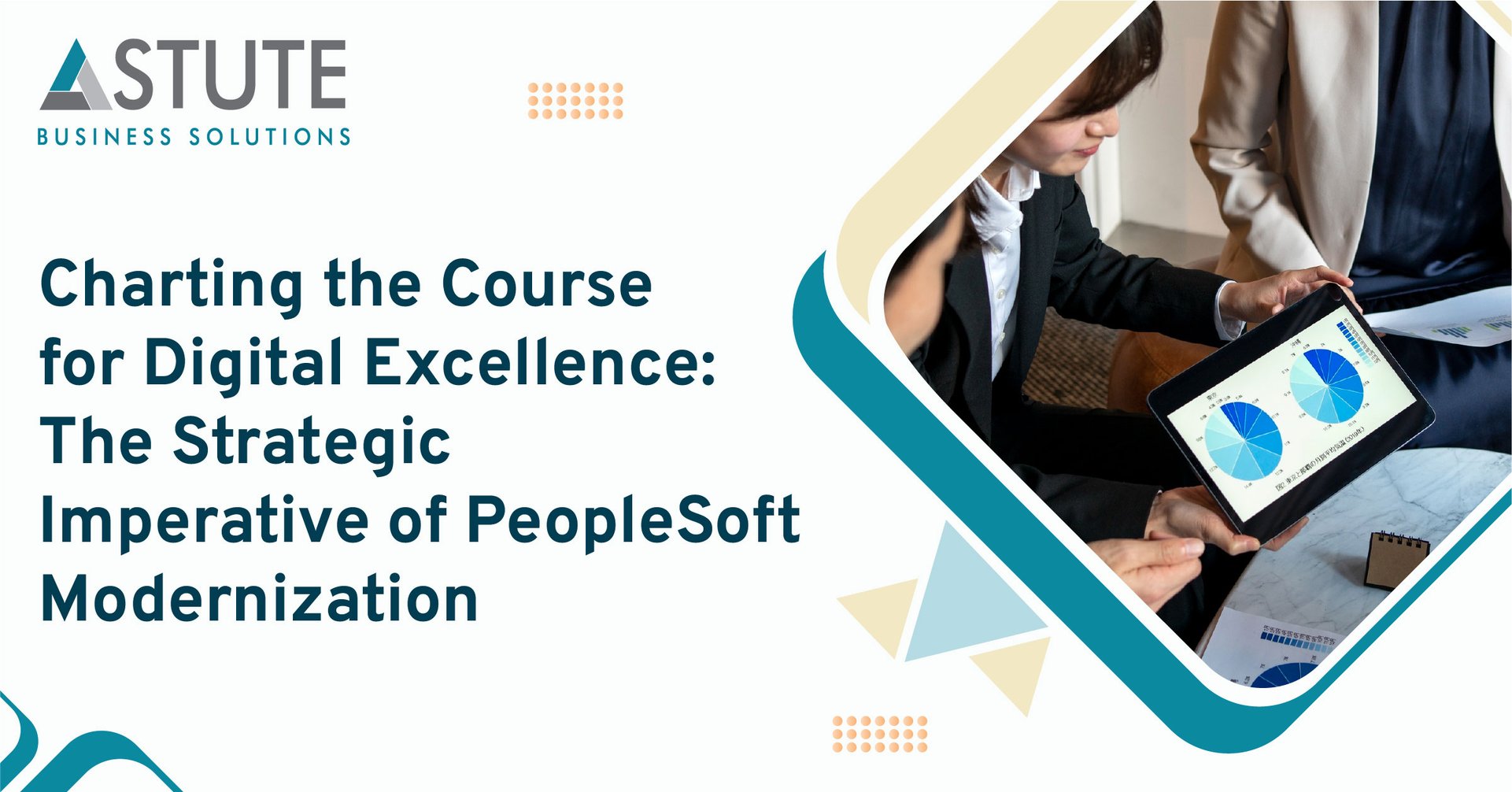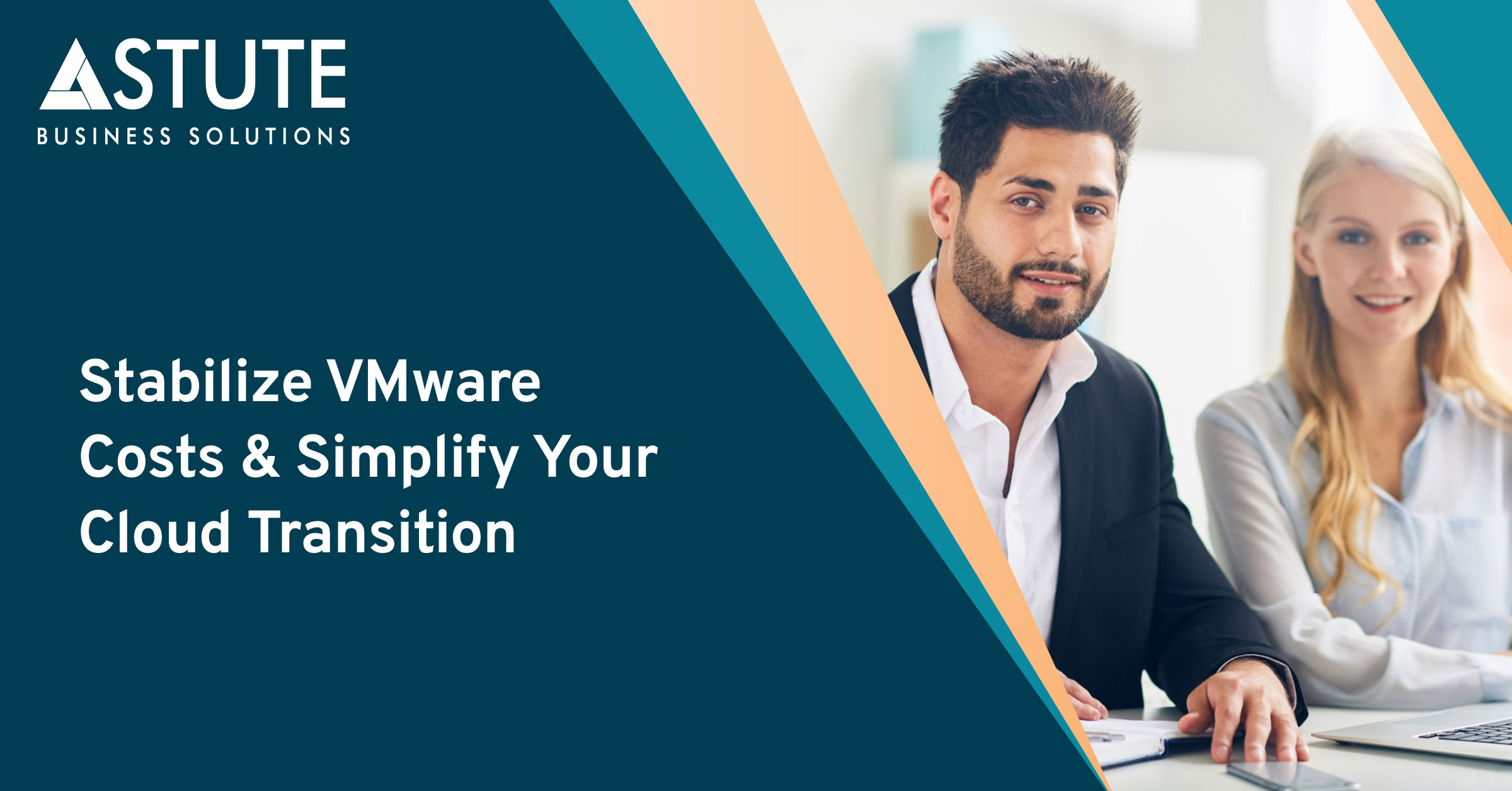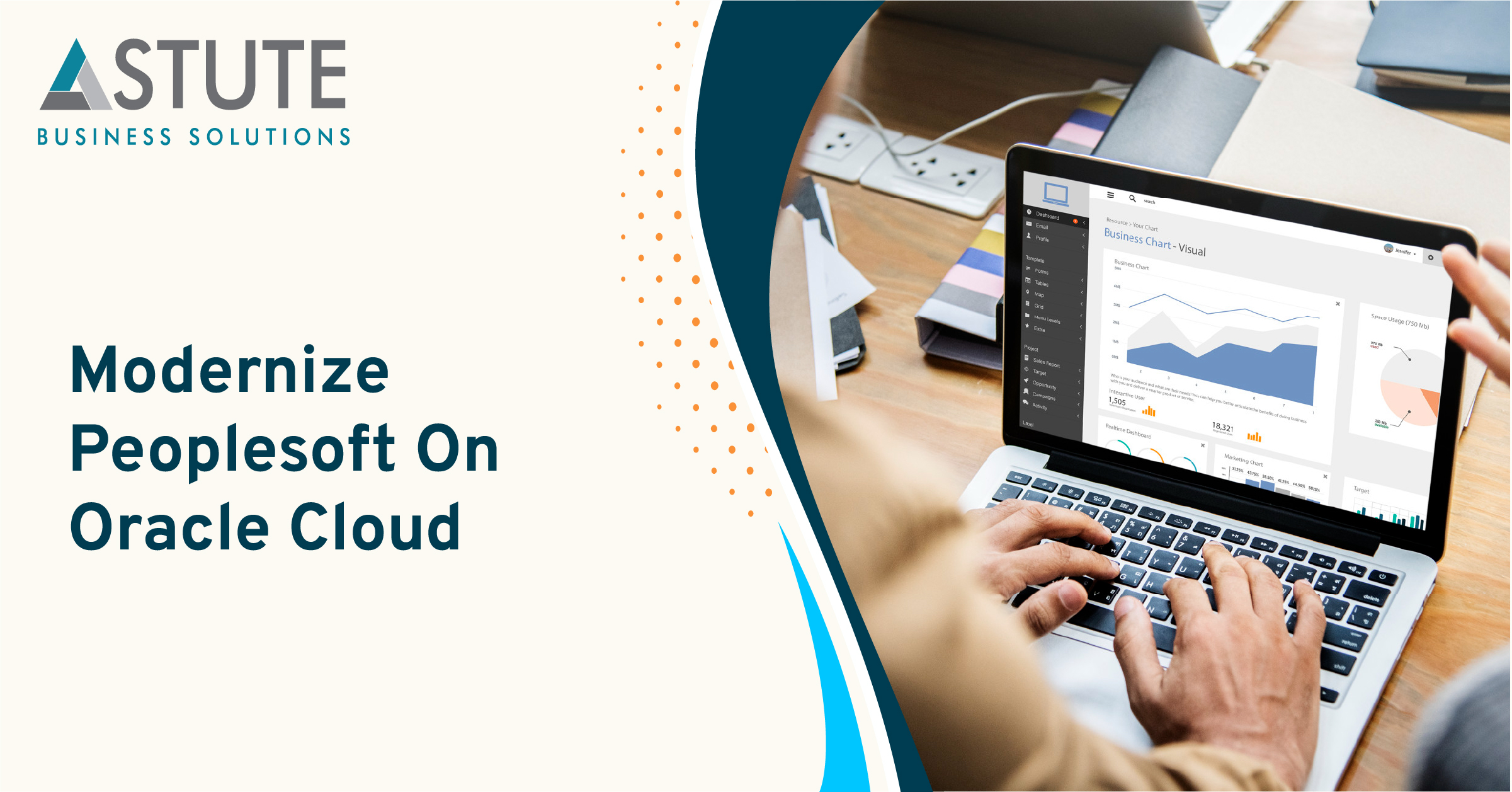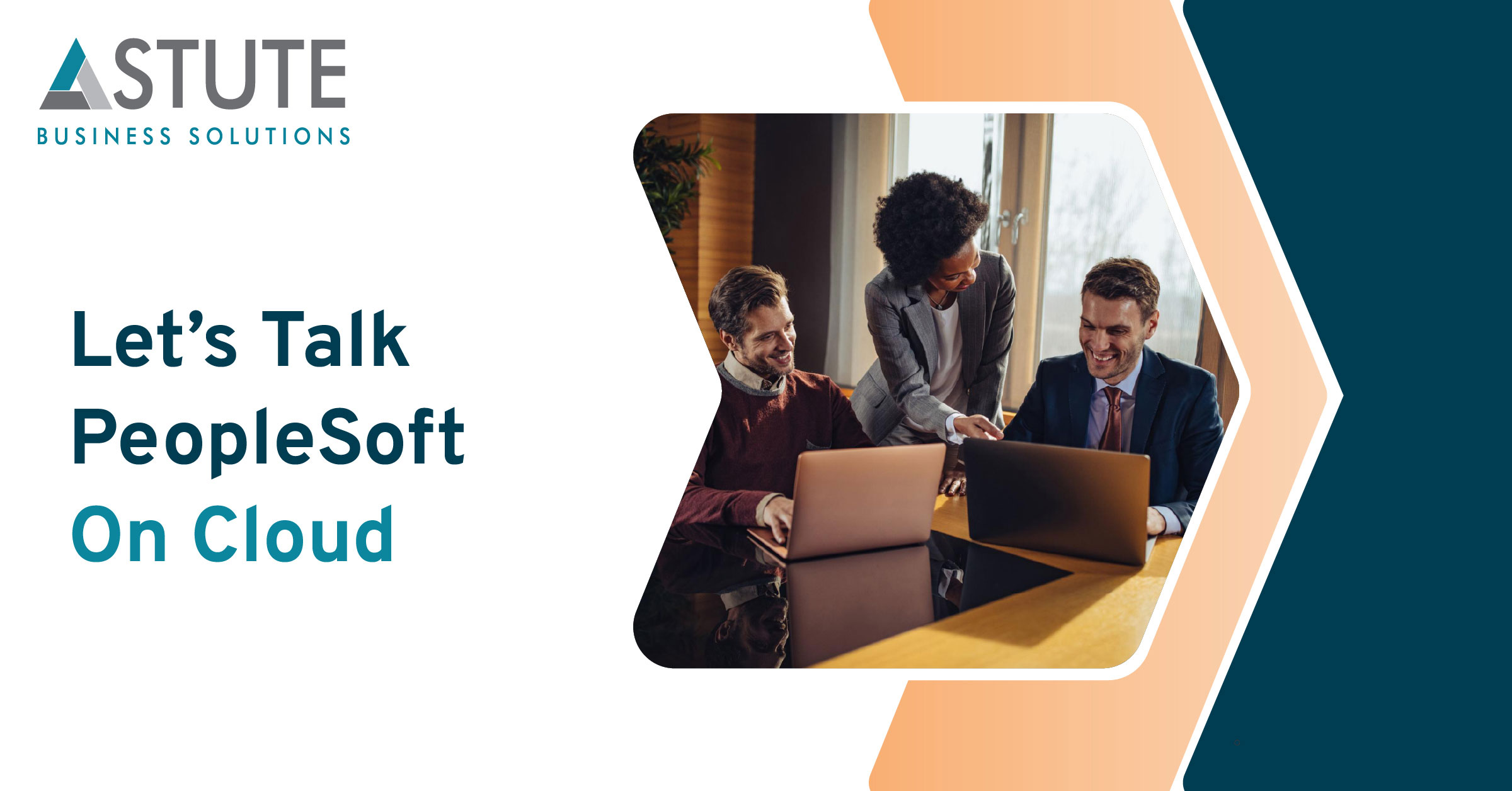Charting the Course for Digital Excellence: The Strategic Imperative of PeopleSoft Modernization

Table of Contents
In a business world dominated by rapid technological advancements, the need to modernize legacy systems like PeopleSoft has become more than a mere operational upgrade. It's a fundamental shift that can significantly impact an organization's efficiency, adaptability, and competitive edge. This modernization journey is about harnessing the power of new technologies to reshape business processes, enhance user experiences, and enable data-driven decision-making.
Understanding the Need for Modernization
The decision to modernize PeopleSoft systems is not just a matter of upgrading software; it's an essential step in aligning an organization with the rapidly evolving landscape of technology. This need for modernization is propelled by several crucial factors that are key to maintaining operational efficiency and securing a competitive edge in today's fast-paced business world. One of the primary drivers is the need to adapt to technological evolution. As technology continues to advance at a breakneck speed, staying current with these developments is vital. Up-to-date systems ensure that businesses are not only keeping pace with their competitors but also leveraging the latest technological innovations to streamline operations and improve productivity.
Enhancing security and compliance is another critical factor driving the need for modernization. In an era where data breaches and cyber threats are increasingly prevalent, ensuring the security of business systems and data is paramount. Regular updates to PeopleSoft bring crucial security enhancements, helping to safeguard sensitive information and ensuring compliance with the latest industry regulations and standards. This aspect of modernization is not just about protecting the organization; it's about building trust with customers and stakeholders who are increasingly concerned about data security.
Improvements in user experience and efficiency also play a significant role in the decision to modernize. Newer versions of PeopleSoft offer more intuitive and user-friendly interfaces, along with streamlined processes that enhance productivity and reduce the learning curve for new users. These improvements in user experience can lead to increased employee satisfaction and efficiency, as users can navigate the system more easily and complete tasks more quickly.
Finally, harnessing data for strategic insights is a key benefit of modernizing PeopleSoft systems. Advanced analytics capabilities offered in newer versions enable organizations to turn their data into actionable insights. This ability to analyze and interpret data effectively is crucial for making informed strategic decisions, identifying new opportunities, and gaining a deeper understanding of market trends and customer behaviors. In today's data-driven business environment, having a system that can provide these insights is invaluable, making the modernization of PeopleSoft an imperative step for organizations looking to thrive and grow in the digital age.
The move to modernize PeopleSoft systems is driven by several critical factors:
- Adapting to Technological Evolution: Keeping pace with technological advancements ensures operational efficiency and competitive advantage.
- Enhancing Security and Compliance: Regular updates bring crucial security enhancements and compliance with the latest regulations.
- Improving User Experience and Efficiency: Newer versions offer a more intuitive, user-friendly interface and streamlined processes.
- Harnessing Data for Strategic Insights: Advanced analytics capabilities turn data into actionable insights for strategic decisions.
Creating a Strategic Modernization Plan
Creating a strategic plan for the modernization of PeopleSoft systems is an intricate process that demands careful consideration and a methodical approach. It's a journey that begins with a deep understanding of where the organization currently stands and a clear vision of where it needs to go. This planning process involves several key steps, each critical to ensuring that the modernization efforts are successful and aligned with the organization's goals and needs.
The first step in this strategic journey is business process analysis. This involves a thorough examination and documentation of the organization's current processes. By understanding these processes in detail, it becomes possible to identify specific areas that would benefit from improvement. This analysis isn’t just about pinpointing inefficiencies; it’s about understanding how these processes interconnect and how they can be optimized to support the organization’s broader objectives. It’s a foundational step that sets the stage for meaningful changes, ensuring that the modernization effort enhances rather than disrupts the workflow.
Following the business process analysis, the next critical step is the technology assessment. This involves evaluating the existing PeopleSoft system’s capabilities and limitations. It’s a process that requires a careful examination of the system's current state, understanding what works well and what doesn’t, and identifying the gaps that modernization can fill. This assessment isn’t just a technical review; it’s an opportunity to align the system’s capabilities with the evolving technological landscape and the organization's future needs.
Enhancing the user experience is another vital component of the modernization plan. The goal here is to create a user interface that is not only more efficient and user-friendly but also aligns with the expectations of modern users. This involves considering how users interact with the system, identifying pain points, and planning for an interface that improves overall efficiency and user satisfaction. A user-centric approach in this regard ensures that the modernized system is not only powerful in terms of capabilities but also delightful to use.
Data management strategy forms the backbone of the modernization plan. In today’s data-driven world, managing data with the utmost integrity, security, and accessibility is paramount. This involves planning how data will be stored, accessed, and used within the new system. It’s about ensuring that the data remains a valuable asset that can be leveraged for insights and decision-making, while also maintaining strict adherence to data privacy and security standards.
Finally, security planning is an indispensable part of the modernization strategy. This involves assessing current security measures and planning for enhancements that align with the latest standards and best practices. In an environment where threats are constantly evolving, robust security measures are critical to protect sensitive information and maintain the trust of customers and stakeholders. This step ensures that the modernized system isn’t just more efficient and user-friendly, but also secure and resilient in the face of emerging cyber threats.
In essence, creating a strategic modernization plan for PeopleSoft is a comprehensive process that covers every aspect of the system—from how it operates to how users interact with it and how it protects and leverages data. It’s a blueprint that guides the organization through a transformation that’s not just technological but also strategic, ensuring that the modernized system is a powerful tool that drives the organization forward in its goals.
A strategic approach to modernization involves several key steps:
- Business Process Analysis: Understanding and documenting current processes to identify areas for improvement.
- Technology Assessment: Evaluating the existing system's capabilities and limitations.
- User Experience Enhancement: Planning for a user interface that improves efficiency and satisfaction.
- Data Management Strategy: Ensuring the integrity, security, and accessibility of data.
- Security Planning: Assessing and planning for robust security measures.
Laying a Solid Foundation for Transformation
Laying the groundwork for a successful PeopleSoft transformation is akin to building a sturdy bridge that connects the current state of your business with its future potential. The process begins with meticulously defining clear objectives. These objectives are not just milestones; they are the guiding lights that ensure every step in the modernization process aligns with what the organization aims to achieve. It's about setting specific, measurable goals that are ambitious yet attainable, ensuring that the modernization journey delivers tangible benefits.
Crafting a tailored strategy is the next critical step. This strategy acts as a blueprint, detailing how the modernization will unfold. It's crafted to resonate with the unique needs of the organization and its users, ensuring that the transition is not only seamless but also adds value at every stage. An integral part of this strategy is developing a realistic and comprehensive project timeline. This timeline is not just about deadlines; it's a carefully choreographed sequence of events that takes into account the complexities of the upgrade and the need for minimal disruption to business operations.
Central to this planning phase is the emphasis on change management. Modernization is not just a technical challenge; it's a human one. Preparing the workforce for this change is crucial. It involves not just training and communication but also addressing the concerns and expectations of those who will use the new system daily. This focus on people ensures that the transition is embraced, not resisted.
Equally important is ensuring the integrity and functionality of data throughout the modernization process. Implementing thorough testing protocols is essential to maintain data accuracy and system functionality. This step is about more than avoiding errors; it’s about building trust in the new system from day one.
Finally, a successful transformation requires a deep understanding of the current system and how it interacts with the new one. This involves stakeholder engagement, where key individuals from various departments are involved in the planning process. Their insights help in gathering diverse business requirements, ensuring that the new system addresses the multifaceted needs of the organization. Conducting a thorough analysis of the existing system helps identify gaps and areas for improvement, while a compatibility and gap analysis ensures that the new system aligns seamlessly with existing infrastructure and business processes. This comprehensive approach ensures that the modernization not only upgrades the technology but also enhances the overall functionality and efficiency of business operations.
Key Steps in Planning
A successful transformation begins with a well-thought-out plan:
- Defining Clear Objectives: Setting specific, measurable goals for what the modernization should achieve.
- Crafting a Tailored Strategy: Developing a strategy that aligns with organizational goals and user needs.
- Creating a Detailed Project Timeline: Outlining a realistic and comprehensive timeline for the modernization process.
- Emphasizing Change Management: Focusing on preparing the workforce for the change to ensure smooth adoption.
- Ensuring Data Integrity and Testing: Implementing thorough testing protocols to maintain data accuracy and system functionality.
Addressing System Compatibility and Requirements
- Stakeholder Engagement: Involving key stakeholders in the planning process to gather diverse business requirements.
- Current System Analysis: Conducting a thorough analysis of the existing system to identify gaps and areas for improvement.
- Compatibility and Gap Analysis: Ensuring the new system aligns with existing infrastructure and business processes.
Overcoming Common Challenges and Pitfalls
Embarking on the path of PeopleSoft modernization, while filled with promise, is also strewn with challenges that demand a proactive and strategic approach. One of the most significant hurdles is the integration of complex systems and processes. This complexity requires careful planning and execution to ensure that the new system harmoniously integrates with existing workflows and technologies. It’s about creating a cohesive ecosystem where all components work in unison, enhancing the overall efficiency and functionality of the business.
Another critical aspect is data migration. This step is not just about moving data from one system to another; it's about ensuring that this transition is accurate, efficient, and secure. It involves meticulously planning the migration process to minimize data loss or corruption, thus maintaining the integrity of critical business data. Aligning business processes with the new system is equally important. This alignment often requires revising current processes to fully leverage the capabilities of the upgraded system, ensuring that the organization doesn’t just adapt to the new system, but thrives with it.
Effective change management is the linchpin in this transformation journey. It's about more than just introducing a new system; it's about guiding the organization and its people through a significant change. Developing robust strategies to manage this change involves understanding the impact on employees, fostering open communication, and providing adequate training and support. This human-centered approach ensures that the transition is smooth and that the workforce is empowered to make the most of the new system.
Complementing these efforts is the need for comprehensive testing and validation. Rigorous testing of the new system is crucial to ensure its reliability and the accuracy of its data. This step is not just a technical necessity; it’s a fundamental aspect of building confidence in the new system, both internally and externally.
Lastly, ensuring business continuity is a pivotal aspect of the modernization process. Understanding how the modernization will impact daily operations is essential for planning. Conducting a thorough impact assessment helps in developing contingency plans to address potential disruptions. Adopting a phased implementation approach can minimize the operational impact of the transition, allowing the business to continue functioning smoothly while the modernization is underway. Keeping stakeholders informed and engaged throughout this process is crucial. Regular communication and training ensure that everyone is on the same page and prepared for the changes, thereby fostering a sense of ownership and ease with the new system. This holistic approach to overcoming challenges and maintaining business continuity is not just about mitigating risks; it’s about creating a foundation for long-term success and resilience in an ever-evolving business landscape.
Risk Identification and Mitigation
Addressing common challenges requires a proactive approach:
- Complex System Integration: Planning for the integration of complex systems and processes.
- Data Migration Strategies: Ensuring accurate and efficient data migration.
- Aligning Business Processes: Revising business processes to align with the new system.
- Effective Change Management: Developing strategies to manage organizational change.
- Comprehensive Testing and Validation: Implementing rigorous testing to ensure system reliability and data accuracy.
Business Continuity Planning
Ensuring minimal disruption to business operations is critical. This involves:
- Impact Assessment: Understanding how modernization will affect daily operations.
- Contingency Planning: Developing plans to address potential operational disruptions.
- Phased Implementation: Adopting a phased approach to minimize operational impact.
- Stakeholder Communication and Training: Keeping stakeholders informed and trained on the new system.
Unlocking the Potential of the Latest PeopleSoft Version
Upgrading to the latest version of PeopleSoft marks a significant leap forward in an organization's technological capabilities. This upgrade brings with it a suite of enhanced functionalities, each designed to streamline operations and foster a more efficient workplace. These new features are not just incremental improvements; they represent a fundamental shift in how businesses can operate, offering smarter, more efficient ways to handle daily tasks. The impact of these enhancements is far-reaching, affecting everything from workflow efficiencies to data management.
Perhaps one of the most immediately noticeable changes is the improved user interface. A more intuitive and user-friendly experience awaits the users, designed to reduce complexity and make navigation smoother. This enhancement is more than just aesthetic; it's about making the software more accessible and easier to use, which can significantly boost productivity and user satisfaction. Alongside this, the advanced data analytics capabilities that come with the upgrade are a game-changer. These tools provide deeper insights into business operations, allowing for more informed decision-making. In today's data-driven business environment, having the ability to quickly analyze and act on data is invaluable.
Furthermore, the upgrade brings increased security and compliance features, ensuring that the organization's data and processes meet the latest standards and regulations. This aspect is crucial in an era where data breaches and cyber threats are increasingly common and can have devastating impacts on businesses.
To fully leverage these benefits, it's important to adopt a structured approach. Regular updates and training are essential to ensure that staff can make the most of the new features. Keeping the workforce abreast of the latest changes and how to utilize them effectively can make a significant difference in the overall efficiency and productivity of the organization. Additionally, conducting an impact analysis of how these new features will integrate with and affect existing processes is vital. It helps in understanding the practical implications of the upgrade and in planning for a smooth transition.
Moreover, testing these new features in a controlled environment before their full implementation is critical. This step ensures that any potential issues are identified and addressed before they can impact the broader system or operations. Controlled environment testing allows for a safe space to understand and refine the use of new features, minimizing the risk of disruptions once they are fully integrated into the daily workflow. This thoughtful approach to maximizing the new features of PeopleSoft not only enhances the immediate benefits of the upgrade but also sets the stage for long-term operational success and adaptability.
Advantages of Upgrading
Upgrading to the latest version of PeopleSoft presents numerous benefits:
- Enhanced Functionalities: Access to improved and new features that streamline operations.
- Improved User Interface: A more intuitive and user-friendly experience.
- Advanced Data Analytics: Better tools for data analysis and decision-making.
- Increased Security and Compliance: Enhanced security features and compliance with latest regulations.
Maximizing New Features
To fully leverage these benefits, consider:
- Regular Updates and Training: Staying updated on new features and training staff accordingly.
- Impact Analysis: Assessing how new features will affect existing processes.
- Controlled Environment Testing: Testing new features in a controlled environment before full implementation.
Migration Best Practices: Ensuring a Seamless Transition
The migration to Oracle Cloud Infrastructure (OCI) is a pivotal step in the modernization of PeopleSoft, representing a significant shift from traditional on-premises infrastructure to a more flexible, scalable cloud environment. This journey begins with a thorough environment assessment, a process that involves evaluating the current infrastructure and resource allocation. This assessment is crucial in understanding the existing setup and determining what changes are needed to ensure a smooth transition to the cloud. It’s about gaining a comprehensive view of the current state and envisaging how it needs to be transformed to harness the benefits of cloud technology. Once the initial assessment is complete, the focus shifts to migration planning and design. This stage involves developing a comprehensive migration plan that is tailored to the unique needs and objectives of the organization. It's a detailed blueprint that outlines the steps and considerations necessary for a successful migration. Part of this process involves the optimization of PeopleSoft for the cloud environment. This optimization is not just a technical adjustment; it's a rethinking of how PeopleSoft can operate most effectively in a cloud-based setting, ensuring optimal performance and leveraging the benefits that cloud infrastructure offers.
However, the path to successful OCI migration is fraught with potential pitfalls that organizations must consciously avoid. One common mistake is underestimating the planning and compatibility requirements. Comprehensive planning and ensuring compatibility with existing systems and processes are critical to prevent disruptions during and after the migration. Another area that requires careful attention is data migration. Implementing robust data migration strategies is essential to ensure that data is transferred accurately and securely to the new environment. This process is key to maintaining the integrity and accessibility of valuable business data.
Equally important is the need for sufficient testing and validation. A migration of this magnitude requires a comprehensive approach to testing, covering functionality, performance, and security aspects. This thorough testing ensures that the system operates as expected in the new environment and helps identify any issues that need to be addressed. Moreover, it's important not to overlook the human aspect of migration - user training and support. Providing adequate training and support ensures that users can adapt to the new system quickly and efficiently, minimizing disruption to business operations.
Post-migration, the focus shifts to ongoing support and continuous improvement. Robust testing post-migration is crucial to ensure the system is fully functional and meeting the needs of the business. Incident management and documentation are also vital components of post-migration support. Establishing clear protocols for handling any issues that arise and maintaining detailed documentation helps in managing the new system effectively. Additionally, continuous monitoring and improvement are essential to ensure that the system remains efficient, secure, and aligned with business goals. This ongoing attention to the system’s performance and functionality ensures that the benefits of the migration to OCI are fully realized and sustained over time.
The journey to Oracle Cloud Infrastructure is a comprehensive process that encompasses careful planning, strategic execution, and ongoing management. By addressing each stage of this process with thoroughness and foresight, organizations can ensure a successful migration that positions them for enhanced efficiency, scalability, and innovation in the cloud era.
The Journey to Oracle Cloud Infrastructure
The migration to OCI is a significant aspect of modernization. It involves:
- Environment Assessment: Evaluating the current infrastructure and resource allocation.
- Migration Planning and Design: Developing a comprehensive migration plan tailored to organizational needs.
- Optimization of PeopleSoft: Adjusting and fine-tuning PeopleSoft for optimal performance in the cloud.
Avoiding Common Migration Mistakes
To ensure a smooth migration, avoid these pitfalls:
- Underestimating Planning and Compatibility Requirements: Ensuring thorough planning and compatibility checks.
- Overlooking Data Migration Strategies: Implementing robust data migration strategies.
- Insufficient Testing and Validation: Conducting comprehensive testing for functionality, performance, and security.
- Neglecting User Training and Support: Providing adequate training and support to users for the new system.
Testing and Post-Migration Support
Robust testing and support are key to a successful migration:
- Comprehensive Testing: Conducting a range of tests to ensure system readiness.
- Incident Management and Documentation: Establishing protocols for managing issues and maintaining detailed documentation.
- Continuous Monitoring and Improvement: Regularly monitoring the system post-migration and making necessary adjustments.
Bringing it All Together
In the contemporary business landscape, marked by rapid technological advancements and shifting market demands, the modernization of PeopleSoft systems emerges as a strategic imperative, not merely an IT upgrade. This comprehensive article has navigated through the multifaceted aspects of PeopleSoft modernization, underscoring its criticality in enhancing organizational efficiency, adaptability, and maintaining a competitive edge. It has illuminated how adapting to technological evolution, bolstering security and compliance, improving user experience, and harnessing data for strategic insights collectively drive the need for modernization.
The creation of a strategic modernization plan has been emphasized as a crucial undertaking. This involves a thorough business process analysis to identify improvement areas, a technology assessment to understand system capabilities and limitations, and planning for an enhanced user interface. Additionally, the development of a robust data management strategy and stringent security planning form the backbone of this transformative journey. These steps ensure that the modernization is not just a technological leap but a strategic enhancement aligning with the organization's broader goals.
Furthermore, the article delves into laying a solid foundation for transformation. It highlights the importance of defining clear objectives, crafting a tailored strategy, creating a detailed project timeline, emphasizing change management, and ensuring data integrity and testing. Such meticulous planning and execution pave the way for overcoming common challenges like complex system integration, data migration, aligning business processes, and comprehensive testing and validation. It also stresses the significance of maintaining business continuity through impact assessment, contingency planning, phased implementation, and effective stakeholder communication and training.
The upgrade to the latest PeopleSoft version brings a host of benefits, including enhanced functionalities, an improved user interface, advanced data analytics, and increased security and compliance. To fully leverage these advancements, regular updates and training, impact analysis, and controlled environment testing are essential.
Lastly, the migration to Oracle Cloud Infrastructure (OCI) is highlighted as a critical aspect of modernization. This journey involves environment assessment, migration planning and design, and optimization of PeopleSoft for the cloud. Avoiding common migration mistakes and ensuring robust testing and post-migration support are pivotal for a successful transition to OCI.
In conclusion, the modernization of PeopleSoft systems is a complex yet indispensable endeavor for organizations aiming to stay relevant and competitive in the digital age. It requires a strategic, comprehensive approach encompassing technology, processes, people, and data. By effectively navigating this journey, organizations can unlock new potentials, drive innovation, and secure a sustainable future in an ever-evolving business environment.

Joe Finlinson
Joe has a deep background in technology and business systems, with a bachelor’s degree in computer science, and a master’s degree in computer information systems. He is comfortable and competent at any stage and level of a project, is ITIL certified, and holds the Computer Information Systems Security Professional certification (CISSP), providing him with a solid framework for the provisioning of IT Services and Cybersecurity. A customer advocate and strategic thinker, Joe enjoys working on technical projects and opportunities to help clients, across all sectors and company sizes, optimize technology investment to provide the right solutions to the challenges businesses face.
Other Articles
Lorem Ipsum is simply dummy text of the printing and typesetting industry.
Stabilize VMware Costs & Simplify Your Cloud Transition
Broadcom recently bought VMware, which is bringing change for the vmware product and vmware...
Let’s Talk PeopleSoft On Cloud
Oracle Cloud delivers 2-10x faster PeopleSoft performance than on-prem Build your path to better...
Subscribe
Our Newsletter
Since every environment is uniquely different we'll customize a solution just for you.
See The Team In Action
Upcoming Events
Reach Out
Ready to Connect?
Please fill the following form, we will get back to you within a business day.
Contact Form
Contact Us


